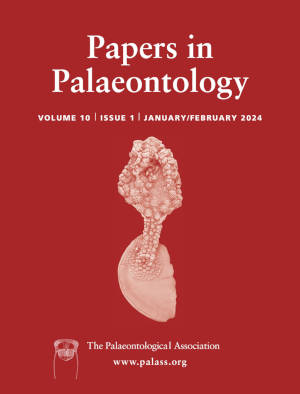Article: Large durophagous fish from the Spathian (late Early Triassic) of Romania hints at earlier onset of the Triassic actinopterygian revolution
Publication: Papers in Palaeontology
Volume:
10
Part:
2
Publication Date:
2024
Article number:
e1553
Author(s):
Lionel Cavin, Thodoris Argyriou, Carlo Romano, and Eugen Grădinaru
DOI:
10.1002/spp2.1553
Abstract
Abstract Fossil evidence suggests that ray-finned fishes (Actinopterygii) diversified greatly after the largest mass extinction event at the Permian–Triassic boundary. This radiation resulted in a diversity peak in the Middle Triassic, which is manifested in diverse feeding specializations, especially among small-bodied Neopterygii. We present new material from an early Spathian (Early Triassic) outcrop in northern Dobrogea, southeast Romania. The material includes isolated jaw and palatal bones that evidently belong to a single individual, a durophagous actinopterygian, and isolated scales referred to the same taxon. A systematic evaluation of this material indicates affinities with †Polzbergiidae, and provides a first glimpse of internal aspects of the feeding apparatus of that group. A pair of ectopterygoids with crushing dentition show a well-developed lateral process, a feature that was previously proposed to be a synapomorphy uniting Cladistia (bichirs) with the Triassic †Scanilepiformes. The recognition of this structure in various Triassic ray-fins (summarized herein) indicates that it was probably widespread among stem neopterygians. The new material belongs to a large individual with a heterodont dentition, therefore representing the earliest large, specialized, durophagous neopterygian. It increases the group's morphological diversity in the Spathian, and hints at an earlier trophic diversification after the mass extinction. Based on new data, we analyse changes in body size of bony fishes through the Early and Middle Triassic. Current evidence suggests that body size distribution remained skewed towards larger sizes in the late Early Triassic, and that the diversification of small-bodied stem neopterygians had not yet been in full swing.
